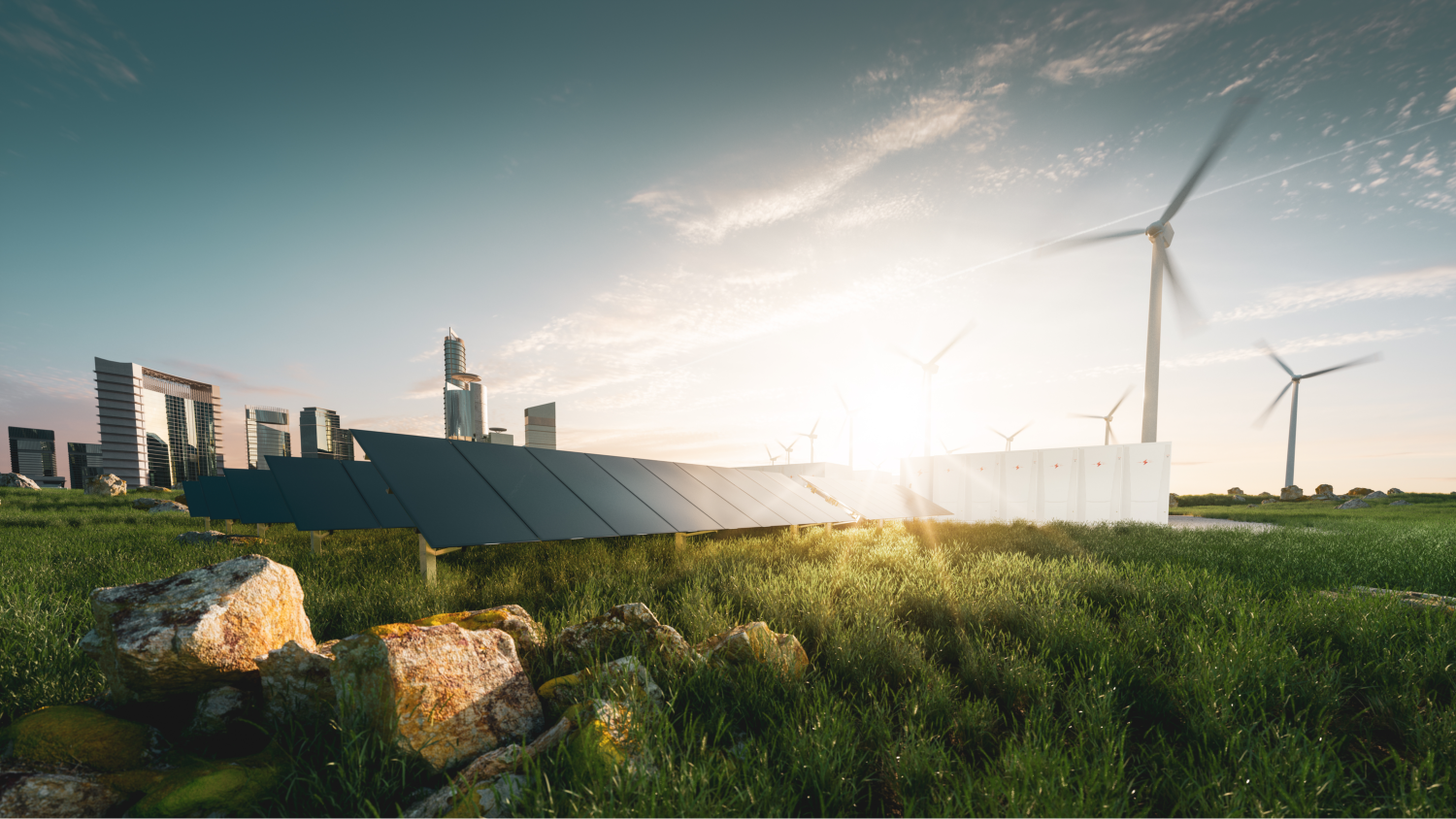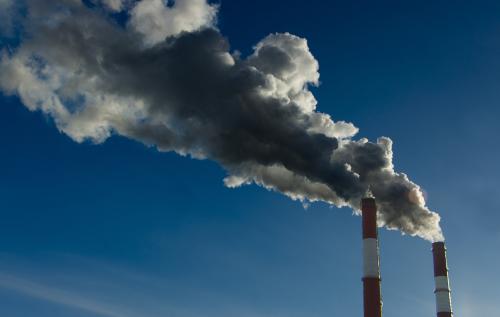The next 30 years are pivotal for the future of the global climate. To have a fighting chance at limiting warming to 2°C, a threshold beyond which Earth may not be able to sustain human life, we need reductions in the range of 25 to 55 percent of cumulative global emissions by 2050. Potentially halving the world’s carbon output in thirty years requires innovation and mobilization on a scale greater than the most ambitious projects ever attempted, like harnessing the potential of atomic energy or landing humans on the moon.
As the largest per capita emitter of CO2, the U.S. has a unique obligation and opportunity to lead the way through a transformative investment in clean energy research and development. The recent bipartisan infrastructure bill is a starting point, authorizing $65 billion for clean energy and grid investments and another $7.5 billion for a national network of electric vehicle charging stations.
But rather than funding numerous, disparate R&D efforts, the U.S. should concentrate the bulk of its funding on a specific set of topics, technologies, and institutions through net-zero innovation hubs. These hubs would represent a geographically concentrated set of public and private sector facilities, laboratories, and universities dedicated to tackling the most uniquely difficult challenges related to the clean energy transition—ones where we do not already have solutions that simply need scale.
Three such challenges are decarbonizing heavy industries, creating a resilient supply chain for critical minerals, and developing a clean energy workforce. Why these three issues amidst the myriad of challenges? They represent some of the principal social, economic, and geopolitical headwinds that could prevent the U.S. from reaching its ambitious decarbonization agenda and will lay the foundation for a successful clean transition.
Heavy industry products like steel, cement, iron, and aluminum are difficult to produce without fossil fuels, and demand for these materials is expected to grow both from infrastructure development in emerging economies and from green energy infrastructure such as wind turbines, solar panels, and batteries.
Meanwhile, the global supply chain is tightening and critical minerals like lithium, nickel, cobalt, and rare earth elements, which are foundational to several green technologies, are held in the hands of few nations, not all of whom are close allies of the U.S. and some have imposed export bans on these minerals before.
These challenges are occurring against the backdrop of a larger societal transformation unfolding in the energy workforce amid coal plant retirements and public pressure to reduce investment in oil and gas. In order to successfully develop a clean energy workforce, new standards and practices are needed to retrain workers from the old energy economy into the new one.
Incubators of innovation that are properly structured and set up for success can overcome these barriers to deep decarbonization and be a real game-changer in the fight against climate change.
To this end, the Department of Energy (DOE) could begin by announcing a competition for cities to submit bids to become homes to these innovation hubs. From here, DOE would activate a unique, one-of-a-kind structure using funds from the recent infrastructure bill. This would include inking public-private partnerships to raise capital in return for access to national laboratories for conducting experiments and demonstrations, sponsoring fellowships and visas to attract top talent from around the world, and issuing long-term federal purchase agreements to support commercializing innovations.
Heavy lifting from heavy industries
The industry sector produces the building blocks of modern life—like cement, steel, iron, and chemicals—but also accounts for nearly 40% of global CO2 emissions every year. In fact, cement is already the most-used substance in the world after water. Because of the extremely high temperatures and chemical processes required to create heavy industry products, fossil fuels are an integral, and often unavoidable, part of their creation.
As explained above, demand is only expected to increase for these materials as emerging economies launch ambitious infrastructure projects. Paradoxically, the scaling up of the green economy will also compound the issue as wind turbines, electric vehicle parts, and carbon capture equipment will require a substantial amount of steel and cement, among other industrial products. As a result, industry-related emissions are on pace to become the largest source of emissions from the U.S. within the next 10 years. Recognizing this, the U.S. helped establish a new G7 Industrial Decarbonization Agenda in May 2021 to push forward new solutions.
A heavy industry net-zero hub should leverage DOE’s new $42 million funding opportunity for next-generation manufacturing processes to focus on novel technologies to decarbonize steel and cement. These two products alone account for 15% of all global emissions and are the leading sources for the most damaging kinds of air pollution. Below we provide examples of possible innovations that a net-zero hub could pursue based on the latest developments in the field.
Almost all the emissions from steel and cement come from two processes: heating a furnace or kiln to extremely high temperatures using fossil fuels and creating a chemical reaction to break down iron ore and limestone which releases CO2 as a byproduct. Altering the heating process has been difficult to achieve, with a few innovative pilots in Sweden, Norway, and the U.K. demonstrating that kiln electrification is technically achievable using plasma technology, biomass, or hydrogen. This is a ripe area of future research.
For steel, hydrogen could eliminate CO2 from the iron ore reduction process entirely. Additional research would be needed to ensure the quality of the steel is not affected as carbon imparts certain desirable properties like hardness and weldability.
For cement, a hub could identify alternatives to “clinker”—an intermediate product created by breaking down limestone—which include blast furnace slag that comes from steel production or certain natural products like gypsum, calcined clay, ground limestone, or volcanic ash. These products are nascent in their use but with further research and successful testing at the hub could represent a nearly 40% reduction in cement emissions.
Given the technical hurdles that exist to decarbonize both steel and cement, the most promising solution to date may be carbon capture, utilization, and storage (CCUS) to remove CO2 from the exhaust stream and pump it underground or use it in another process. Though there are only 27 operational CCUS projects online right now, the International Energy Agency (IEA) forecasts that this technology will be responsible for nearly 20% of emissions reductions in the industrial sector. One key innovation a net-zero hub could advance for CCUS is calcium-looping technology, which has only been demonstrated at limited pilot scales. This takes the lime produced from cement clinker and steel to improve CO2 capture efficiency.
On the rocks: addressing the scarcity of critical minerals
A crucial area needing focused innovation is critical minerals. The whole world is undergoing a clean energy transition at the same time and the building blocks for those technologies—like copper, lithium, nickel, cobalt and rare earth elements (REE) —are already seeing astronomical demand. Indeed, copper prices have risen 70% during the pandemic.
As of today, the U.S. imports 31 of the 35 critical minerals and has no domestic production at all for 14 of them. There is only one operating lithium mine in the country. To address this, a critical minerals hub should be stood up to identify mineral and technological substitutions where there is supply chain and environmental vulnerability, open mines to access domestic sources of REEs, and improve the technology for mineral recycling and recovery. Without this kind of innovation, the clean transition will be at the mercy of unpredictable price volatility, supply chain disruptions, and geopolitical extortion from a handful of countries who control access to most of the minerals.
Take, for example, wind power and electric vehicles. They are both highly dependent on neodymium, a rare earth element without which they could not manufacture the magnets needed to operate the motors. Nearly all of this mineral is mined and processed in China, which once banned all exports of neodymium and other REEs to Japan over a fishing dispute.
 Source: IEA (2021), The Role of Critical Minerals in Clean Energy Transitions. All Rights Reserved.
Source: IEA (2021), The Role of Critical Minerals in Clean Energy Transitions. All Rights Reserved.
What would we do if this happened again over a different political or trade disagreement? Wind turbines are ill-equipped to switch to non-magnet or hybrid gearbox configurations. Production of electric vehicles using permanent-magnet synchronous motors (almost all of them) would have to be halted and switch to something more nascent, like induction motors.
Towards this end, the hub can leverage the infrastructure bill’s $7 billion investment in batteries and critical minerals to open more mines at home in Wyoming, Texas, and California, where REEs like neodymium, dysprosium, and terbium are found, or scaling alternative motor designs not reliant on these minerals at all.
A more straightforward path could be developing better recycling of these minerals from electronic waste or enhanced recovery from mining sites itself. Hubs should develop advanced metallurgical separation techniques to optimize the waste streams of batteries, solar panels, and personal electronics to become secondary supply sources. They should also develop advanced extraction tools using robots and autonomous drones to get minerals left behind in mining residues, slag, sludges, and tailing.
IEA estimates that meeting the commitments of the Paris Climate Agreement would require a quadrupling of mineral requirements for clean energy technologies by 2040. A net-zero hub tasked with finding redundancies and alternatives is critical to ensure we can successfully scale clean energy globally.
Making it happen: Growing the clean energy workforce
Even if we are able to find technical solutions for hard-to-abate sectors and secure the raw materials needed for green technologies, bringing the clean transition to life requires a skilled clean energy workforce. Twelve states have required their utilities to generate 100% clean electricity by 2050 or earlier. Achieving this will require unprecedented levels of investment in workforce development. We propose a third priority area in the clean energy workforce of the future.
Luckily, a skilled, energy-savvy workforce exists in the fossil fuel sector right now. The oil, gas, and coal sectors employ nearly 1.5 million Americans, primarily in Texas, Oklahoma, Louisiana, West Virginia, Kentucky, Wyoming, and Montana. Given the geography and topography of these states, there is actually an impressive overlap between where fossil fuel jobs are now and where renewable energy generation could be happening.
As the clean transition accelerates slowly but surely, over time certain kinds of jobs in the fossil fuel industry will no longer exist. Acknowledging this reality is an important step to proactively prepare for a just transition, where workers and communities in the fossil economy are able to find meaningful and well-paying jobs in the green economy. These are workers already highly skilled in operating complex equipment and machinery and understanding electrical systems, making the path to retraining quite feasible.
Getting this right is of paramount importance. In some cities in the states mentioned above, 30% to 50% of all workers are employed in the fossil fuel industry. Without providing them a foundation into the clean energy industry, the social and political blowback could result in just a handful of elected representatives derailing any sustained clean energy investment at the federal and state levels.
Thankfully, federal investment in new transmission lines, battery storage, and renewables could serve as significant sources of employment. The infrastructure bill is expected to create 2 million jobs annually overall, spanning a variety of sectors. The bill also involves standing up a new Energy Jobs Council to oversee the development and release of energy jobs as they arise. This makes a coherent clean energy workforce strategy urgent and critical. Net-zero hubs should be located in these vulnerable Southwest and Midwest states and take advantage of hundreds of millions in the infrastructure bill specifically carved out for workforce development in electric grids, clean buildings, and the industrial sector.
Hubs can house and facilitate apprenticeship programs targeted at young adults in these communities where they can connect them with clean energy companies, utilities, and energy efficiency businesses. Union groups like the Utility Workers Union of America can provide a training model for these hubs as they have already developed a curriculum for their members to work on onshore and offshore wind, battery storage, and solar power. One interesting synergy is re-orienting fossil fuel communities to support production and processing of critical minerals—an approach DOE is already pursuing.
More broadly, the hubs can work with universities to create “pathway” programs for high school students to take classes on renewable energy, electricity networks, and climate change for college credit, ultimately making higher education more accessible. There is a unique opportunity here to provide a path to lift up low-income and underserved communities in line with Biden’s Justice40 executive order which mandates that 40% of the benefits of federal climate investments flow to disadvantaged communities.
Standing up net-zero hubs
Each net-zero hub would be tasked with addressing one of these challenges and would be equipped with the authority and funding to marshal together the top talent to come up with solutions. Through proofs of concept, demonstration projects, patents, and reports, these hubs will provide a body of knowledge that will help accelerate the clean transition in the U.S. and globally.
To carry out this ambitious R&D agenda, net-zero hubs should follow three overarching policies that have seen success around the world.
1) Concentrate talent and research around specific geographies.
Hubs should strive to bring together the whole spectrum of clean energy stakeholders: researchers, engineers, entrepreneurs, students, venture capitalists, and policymakers. Metropolitan cities like Atlanta, New York City, Chicago, San Francisco, Dallas, and Houston make intuitive sense as they have access to large international airports and are already co-located with robust research universities and industry players.
This models the approach of the Fraunhofer-Gesellschaft—a network of 69 research institutes throughout Germany which are grouped into “alliances” or “clusters of excellence” covering specific research areas like batteries, integrated energy systems, or the circular economy. The geographic and topic concentration enables these groups to avoid duplication through coordinated research and pooling of resources.
For more technical collaboration and testing, hubs can leverage one of the Department of Energy’s seventeen National Laboratories. These are cutting-edge, high-quality facilities with experienced scientists and a track record of fostering technological breakthroughs. This hybrid model of public-private facility sharing has seen success in India through its Central Power Research Institute (CPRI). For the past 50 years, CPRI has been a shared collaboration space by government, industry, and utilities helping launch innovations in high-voltage transmission lines, smart meters, and micro-grids.
2) Provide long-term federal support and funding.
Putting together this collaborative infrastructure will be an expensive prospect. Long-term federal support is critical to ensure researchers have the time and resources to acquire the necessary equipment, recruit staff, run experiments, and eventually scale new technologies for commercial success. One example of providing that support is the Innovation Network Corporation of Japan where the government has offered $8.5 billion in loan guarantees for the corporation’s investments in energy and infrastructure in case the end products are not commercially profitable.
With funding available from the infrastructure bill, the U.S. could go even farther in establishing long-term purchase agreements for the outputs of net-zero hubs in line with President Biden’s December 2021 executive order to decarbonize all federal operations by 2050.
3) Enable easy access to STEM talent.
Policy changes will need to go beyond opening access to laboratory facilities and funding to include immigration policies that make it easy to attract the top STEM talent in the world. Nearly half of Fortune 500 companies were founded by immigrants or the children of immigrants—this is America’s differentiating advantage in R&D. Hubs should leverage current efforts by the Biden administration to reduce barriers to legal immigration through expanded access to J-1, O1-A, and F-1 visas for undergraduate and graduate students in STEM fields and beyond.
Once the core infrastructure and design of the net-zero hubs are put in place, it’s time to get to work. Together, these three supporting policies will help overcome the “valley of death” for new clean energy innovations—the gap between basic research and scaling production into successful commercialization.
These hubs are specifically designed to address deep decarbonization challenges, not promote marginal improvements in existing technologies. To that end, the challenges that lay ahead for heavy industry products, the supply chain for critical minerals, and the growth of a clean energy workforce in a fossil-fuel dominated economy remain vast but solvable.
Conclusion
To actualize this vision of a clean energy future, there are two immediate steps that DOE could take to arrange financing and leverage existing partnerships with universities and the private sector.
First, DOE could take stock of the $65 billion it received through the infrastructure bill and determine how much of it can be used to stand up these hubs. While the efforts will be jointly funded with interested private sector parties—like large energy companies—initial seed capital from the federal government will help grease the wheels to demonstrate that the federal government is serious about tackling these issues in a major way.
Second, DOE could explore partnering its new Office of Clean Energy Demonstrations with the National Science Foundation’s (NSF) National Innovation Network I-Corp’s Hubs. NSF describes the I-Corp Hub as “a network of universities, NSF-funded researchers, established entrepreneurs, local and regional entrepreneurial communities, and other federal agencies” that “help researchers learn how to translate fundamental research to the marketplace.” Fleshing out what existing university and entrepreneurial networks federal researchers have created will help DOE refine its search criteria of where its hubs can be located.
Net-zero hubs will bring together the best of American ingenuity. They will focus the best and brightest from the private, public, and academic sectors on solving the challenge of heavy industry-sector emissions, critical minerals, and the clean energy workforce. The technologies and practices that emerge from these hubs will be game-changing in these next few pivotal decades as the future of the climate hangs in the balance.








